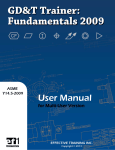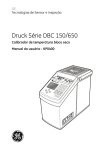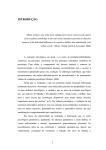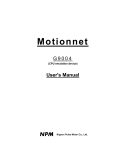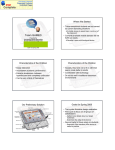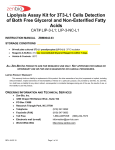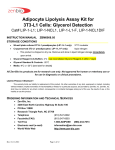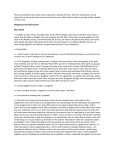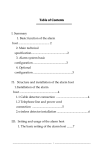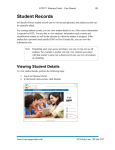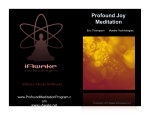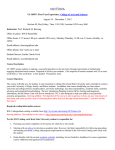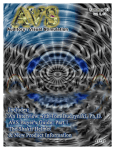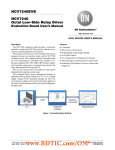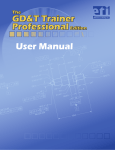Download Memory Wonder Wizard & IQ Enhancer Wizard User Manual
Transcript
Memory Wonder Wizard & IQ Enhancer Wizard User Manual IMPORTANT: Please read this manual carefully before your first use. These recordings are not “music” in the traditional sense. They are a series of finely honed and sculpted frequencies that have been painstakingly arranged in such a way as to have a profound and beneficial effect when used regularly with or without headphones. Headphones are not necessary but suggested for maximum benefit. These recordings are best listened to at the highest comfortable volume, with your eyes closed. It may take multiple sessions for your brain to “learn” how to react to this form of stimulation. Following the usage protocols/patterns for each recording is paramount to your chances for success. As with physical exercise, it is important to listen to the audio for a consecutive 30 days period as if giving your brain a ‘massage’ every day for a month. The more you use these recordings, the more positive changes you will be likely to manifest. If you were to exercise once in a while, you would not see much of a difference in your conditioning or health (if any). Do it regularly and you will experience the changes to your life. It is the same with your brain. Do it regularly and you will get results! Due to the inconstancies in PC sound cards and speakers, it is suggested that you burn the audio onto a separate CD of each recording to ensure that you do not miss out on any of the experience. What is Brainwave Entrainment? When the brain is stimulated with pulsed sounds (neuro – electrical activity via the nerves originating from the ears), the overall activity of the brain will respond to and align with these pulses (also called the FFR or “frequency following response”). By selecting the desired rate, the brain, via the FFR, can be naturally induced towards the selected brainwave state and its inherent benefits. It is also because of the FFR or “entrainment” that these pulsed sounds often produce benefits similarly found with deep meditation. It is entirely possible that each use will provide a unique experience. Even if you feel nothing happened, pay close attention to yourself and see if you, or your friends, co-workers or family notice anything different. One of the great things about BWE is that it can be used on its own, or with many other modalities as an adjunct to intensify the effects of pretty much whatever you choose to use with it. What sensations might you expect when using our BWE based recordings? • Some of the effects you may experience with our BWE recordings may be influenced by things like how “busy” your mind is, “whether you’re preoccupied”, how willing you are to “let go”, to name but a few. • You may find that you experience “lost time”. It’s common to find that a 30 minute recording is over and it only felt like 10 minutes. • When tension moves out of your muscles and other parts of your body, you can expect a number of possible sensations, some of which you may have never experienced before. These may include tingling, a floating sensation, momentary numbness, muscle twitches, feelings of flowing warmth, heaviness. • You may find that your mind wanders. • Some people may feel themselves falling asleep during a session which is absolutely normal. :-) • Some people may experience slight headaches or maybe large headaches initially because of the rush of blood that’s going to the brain. Your brain is a muscle and it’s really getting a workout. It’s like you get a sore muscle after a heavy work out if your brain isn’t used to handle that much blood flow. You should shorten your listening time until your headache fades away, then you may listen to it longer next time. •Please share your experiences if yours aren’t mentioned above. General Listening Instruction • You may listen to the recordings with, or without headphones. It’s up to your personal preference. • You should listen to these recordings at the highest possible volume while still being “COMFORTABLE”. You don’t want to strain yourself; the idea is that the louder the sounds, the deeper the BWE may be (due to the increased stimulation to the brain). COMFORT is very important. If you listen to the recordings at too high a volume, you are working against the purpose of these recordings • Under no circumstances should you drive a car or operate potentially dangerous machinery/equipment while listening to these recordings. Memory Wonder Wizard Instruction • See “General Listening Instructions” • Play this recording while studying, reading non-fiction, or performing an activity that can benefit from increased cognitive performance. It will increase your focus, memory and mental speed. • For best result, find a quiet place to study and listen to this recording with headphones. You may want to set it to LOOP if needed. IQ Enhancer Wizard Instruction • See “General Listening Instructions” • Do NOT set it to LOOP. You may however listen to it again 6 hours later if needed and do not exceed 2 times per day. • For best result, make sure you are sitting or lying down comfortably, close your eyes and try to relax when listening to this recording. Frequently Asked Questions Question: Is Brainwave Entrainment safe? Answer: Brainwave Entrainment is safe when used according to guidelines. You are only being guided into naturally occurring brain wave patterns you enter everyday anyway. However, those who should not use this application include: pregnant women and those who are wear a pacemaker, or are have had or are prone to seizures, are epileptic, whether knowingly or not, should not use this application. Those who should consult a physician before the use of this product include: individuals under the influence of medication or drugs. This application is not to be used while under influence of alcohol or other mood altering substances, whether they are legal or illegal. Children under the age of 18 are to be examined by a physician for epilepsy or illnesses that may contribute to seizures prior to the use of the audio. Finally, DO NOT LISEN TO Memory Wonder Wizard and IQ Enhancer Wizard While Driving Or Operating Machinery. Question: Do I need any special audio equipment to use Brainwave Entrainment? Answer: Overall, equipment quality will not hinder the effectiveness of the Brainwave Entrainment. All you need is a CD or mp3 player Question: Do I need to use headphones with these recordings? Answer: No. Brainwave Entrainment will be stronger using headphones, but you can listen without them as well and still gain benefits. Question: What is the "cortical evoked response" (CER)? Answer: Essentially, it is the brains neuronal firing rate response to (in this case) an auditory stimulus. The strength of the CER is directly related to the strength or volume of the sound wave as well as the frequency being applied. Question: Can I listen to the soundtracks while I do other things? Answer: You should listen to the soundtracks exactly as described in the users’ manual. Never listen while driving or operating any kind of potentially dangerous equipment. Question: What happens if I miss a day or two? Answer: It is best to use the program according to the manual, but sometimes you just won't be able to. If you have to miss a day, that's OK. You may adjust your use of the system to fit your life-style. Again, every day is best, but if you can only use it five times a week, or every other day, you will still benefit (just not as quickly). Question: If I am distracted by sounds, my body, or my thoughts or feelings, will it alter the effectiveness of the recordings? Answer: No. It does not matter if you attain any particular state, or if your mind is quiet. The entrainment is always easier if you "go with the flow", so whatever happens, just sit or lie back and enjoy it. Question: I have hearing loss. Will the program work on me? Answer: As long as you have some hearing, it should work fine for you. Some people have even reported results when "listening" was from inner ear vibration alone. Question: How long before I experience results? Answer: Our brainwave entrainment recordings will begin to create change the first time you use them. You may not notice the changes for a few weeks or even a few months. Remember, it's just like exercise, if you exercise every day you would expect to see differences after a time. It is exactly the same with your brain. Research & Further Reading Academic Performance Enhancement with Photic Stimulation and EDR Feedback. Thomas Budzynski, Ph.D., John Jordy, M.Ed., Helen Kogan Budzynski, Ph.D., Hsin-Yi Tang, M.S., and Keith Claypoole, Ph.D., Journal of Neurotherapy, 3(3), 11-21. Audio-Visual Entrainment (AVE) Program as a Treatment for Behavior Disorders in a School Setting, Michael Joyce & Dave Siever, 1997, Journal of Neurotherapy, vol 4 (2), 9-32. Differences in EEG Alpha Activity Related to Giftedness. Jausovec, N. (1996)., Intelligence, 23, 159-173. Resting EEG theta activity predicts cognitive performance in attention-deficit hyperactivity disorder. Hermens DF, Soei EX, Clarke SD, Kohn MR, Gordon E, Williams LM., 2005 EEG Average Frequency and Intelligence. Giannitrapani, D. (1969)., Electroencephalography & Clinical Neurophysiology, 27, 480-486. A pilot investigation of auditory and visual entrainment of brain wave activity in learning disabled boys. Carter, J. L., & Russell, H. L. (1993). Texas Researcher, Journal of the Texas Center for Educational Research, 4, 65-73. Neurophysiology. 4, 289-296. EEG Alpha Rhythm Frequency and Intelligence in Normal Individuals. Anoukhin, A., Intelligence, 23: 1-14 EEG differences in ADHD-combined type during baseline and cognitive tasks., Swartwood JN, Swartwood MO, Lubar JF, Timmermann DL. Intelligence, Academic Achievement, and EEG Abnormalities in Hyperactive Children, Am J Psychiatry 131:4, April 1974, James H. Satterfield, M.D., Dennis P. Cantwell, M.D., Ronald E. Saul, M.D., Alvin Yusin, M.D. Exceptional Results with 'Exceptional Children', Lynda Thompson, Ph.D. and Michael Thompson, M.D., 1995 International Society for Neuronal Regulation Conference New Visions School NeuroTechnology Replication Project 2000 - 2001, Michael Joyce Electroencephalographic Biofeedback of SMR and Beta for Treatment of Attention Deficit Disorders in a Clinical Setting, Lubar, J. O., and J.F. Lubar. Biofeedback and Self Regulation 9, no. 1 (1984) 1-23 Righting the Rhythms of Reason: EEG Biofeedback Training as a Therapeutic Modality in a Clinical Office Setting. Tansey, M.A., Medical Psychotherapy 3 (1990): 57-68 EEG Training for ADHD and Learning Disorders, Othmer, S & Othmer, S.F., March, 1989 Attention deficit disorder. Othmer, S. (1998). EEG Spectrum Training Syllabus. Volume 3. Encino, CA: EEC Spectrum. EEG and behavioral changes in a hyperactive child concurrent training of the sensorimotor rhythm (SMR). A preliminary report. Biofeedback and Self-Regulation, 1, 293-306. Lubar, J.F., Shabsin, H.S., Natelson, S.E., Holder, G.S., Whitsett, S.F., Pamplin, W.E., and Krulikowski, D.I. (1981). The Physiological Response to "Beta Sweep" Entrainment, Gontgovsky, S., Montgomery, D., Proceedings AAPB Thirteenth Anniversary Annual Meeting (1999) Discourse on the development of EEG diagnostics and biofeedback for attention-deficit/hyperactivity disorder. Lubar, J. F. (1991)., Biofeedback and Self-Regulation, 16, 201-225. Evaluation of the effectiveness of EEG neurofeedback training for ADHD in a clinical setting as measured by changes in T.0.V.A. scores, behavioral ratings, and WISC-R performance. Lubar, J. F., Swartwood, M. 0., Swartwood, J. N., & O'Donnell, P. FL (1995). Biofeedback and Self-Regulation, 20, 83-99. Quantitative analysis of EEG in boys with attention-deficit-hyperactivity disorder: Controlled study with clinical implications. Mann, C. A., Lubar, J. E, Zimmerman, A. W., Miller, C. A., & Muenchen, R. A. (1992). Pediatric Neurology, 8,30-36. Intellectual, auditory and photic stimulation and changes in functioning in children and adults. Russell, H. L. (1997). Biofeedback, 25(1), 16-17, 23, 24. A pilot study of the effect of 18 Hz audio visual stimulation (AVS) on attention and concentration symptoms and on quantitative EEG (QEEG) in long-term chronic fatigue (CFS). Trudeau, D. L., Moore, J., Stockley, H., & Rubin, Y. (1999). Journal of Neurotherapy 3~4), 76 A controlled study of the effects of neurofeedback training on IQ and EEG patterns for ADD subjects. Utter, C. P. (1996). Unpublished manuscript. College of Wooster. Brain metabolism in teenagers with attention-deficit hyperactivity disorder. Zametkin, A. I, Liebenauer, L. L., King, A. C., Minunkas, D. V., Herscovitch, P., Yamada, E. M., & Cohen, R. M. (1993). Archives of General Psychiatry, 50, 333-340.









